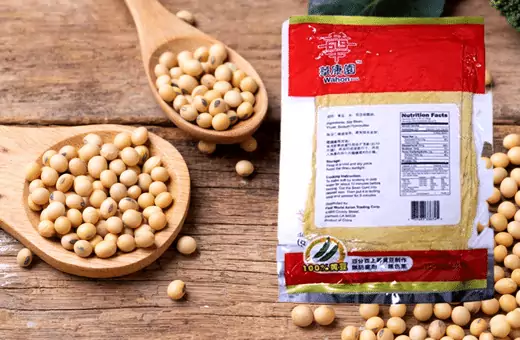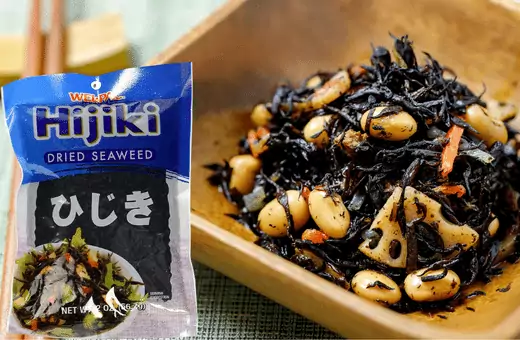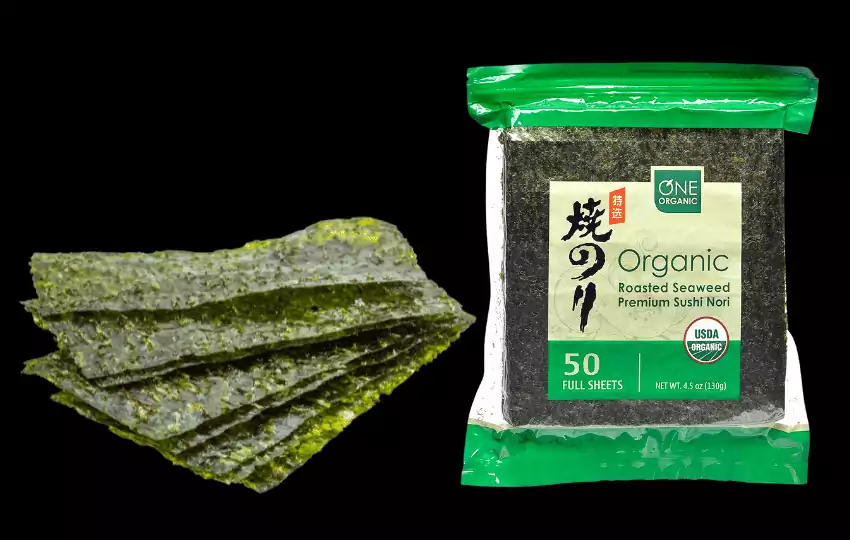If you’re a fan of sushi like me, you probably know that wraps made from nori sheets are the perfect vessel for your favorite fillings. But make sushi without nori sheets? It seems impossible.
Don’t worry; we’ve got you covered, there are plenty of other ingredients that can help you create the perfect rolls for sushi without seaweed.
Here are thirteen substitutes for Nori sheets that will let you make delicious sushi right at home and trust me each Nori substitute makes the sushi more flavorful and unique.
What are nori sheets?
Nori sheets are a type of edible red algae seaweed that is often used in sushi.
Nori sheets are dried and then pressed into thin sheets. The sheets are then cut into small pieces and used to wrap sushi rolls also in onigiri (rice balls). Nori sheets are also used to make sushi rice balls.
Can you make sushi without nori sheets?
You can make sushi without nori sheets, but it’s not traditional. Nori sheets are used because they’re a good way to bind the ingredients together and they add flavor and crunch. If you don’t have nori sheets, you could try using a few lettuce leaves instead or some kind of wraps like rice paper or soy paper, also thinly sliced cucumber, and more.
Without nori can be just as delicious and satisfying as sushi made with nori. experiment with different ingredients and fillings to find your perfect sushi combination!
If you don’t have sushi rice, you can use any kind of short-grain rice. Just make sure to rinse it well before cooking and to cook it according to the package directions.
As for the fillings, you can really use anything you want. Traditional sushi has fish or vegetables, but feel free to get creative. Some good options include avocado, cucumber, carrot, mango, salmon, tuna, and shrimp.
To make the sushi, start by layering the nori sheet alternative on a bamboo mat or piece of plastic wrap. Spread a layer of cooked rice over the nori, leaving a 1-inch border at the top. Arrange your fillings in the center of the rice. Wet your fingers with water and lightly dampen the top border of the nori.
Roll up the sushi, starting at the bottom and using the mat or plastic wrap to help you shape it into a nice, tight roll. Wet your knife with water and slice the sushi into pieces. Serve immediately with soy sauce, pickled ginger, and wasabi (if desired). Enjoy your new sushi without any nori or seaweed.
What can You use instead of nori sheets?
You can use Hijiki, Dried edible red alga, Kim, Shiso, Origami wraps, Rice paper, Omelete, Aonori, tofu skin, Salmon, collard green, soy sheet, thinly sliced cucumber or daikon radish, etc and continue to explore more about them.
1. Sushi with rice paper instead of seaweed
If you are looking for a delicious and healthier way to enjoy sushi, then try using rice paper instead of seaweed. Rice paper is a great alternative to seaweed because it is lower in calories and fat, and it also provides a good source of fiber. You can find rice paper at most Asian markets or online.
2. Wrap thin omelet- Make sushi without nori
This sushi wrap is made with a thin omelet instead of seaweed. It’s a delicious and easy way to enjoy sushi at home!
Ingredients:
-1/2 cup cooked sushi rice
-1/4 cup diced cucumber
-1/4 cup diced avocado
-1/4 cup diced mango
-2 tablespoons imitation crab meat (optional)
For the omelet:
-3 eggs, beaten well
-Pinch of salt and pepper
Instructions:
1. In a small bowl, combine the cooked sushi rice, cucumber, avocado, mango, and imitation crab meat (if using). Mix well and set aside.
2. In a medium-sized bowl, whisk together the eggs, salt, and pepper.
3. Heat a small frying pan over medium heat and spray with cooking spray. Pour in half of the egg mixture and cook until set, flipping once. Remove from the pan and repeat with the remaining egg mixture.
4. To assemble the wraps, place 1/4 cup of the rice mixture in the center of each omelet. Roll up tightly and cut in half. Serve immediately. Enjoy!
3. Tofu Skin
This sushi wrap is made with tofu skin instead of seaweed, making it a delicious and healthy option for those looking for a meat-free meal.
The tofu skin gives the wrap a slightly chewy texture, while the rice and vegetables provide a crunchy contrast. This wrap is perfect for a quick lunch or light dinner.
4. Salmon
This sushi wrap is a healthier alternative to traditional sushi rolls, as it uses thinly sliced salmon in place of seaweed. The salmon is wrapped around a rice and vegetable filling, making for a delicious and nutritious meal.
5. Colard Green
If you’re in the mood for something a little different, why not try making your sushi wrap with Colard Green instead of seaweed? It’s a tasty and healthy alternative that’s sure to satisfy your cravings.
Plus, it’s a great way to get your daily dose of greens. So why not give it a try? You might just be surprised at how delicious it is.
6. Thin sliced cucumber
Sushi wrap with thinly sliced cucumber instead of seaweed. Spicy tuna, salmon, yellowtail, whitefish, and avocado with house sauce. This is a healthier version of the sushi wrap, and it is just as delicious!
The cucumber provides a refreshing crunch, and the house sauce adds a perfect amount of sweetness and spice. A sushi wrap is a great option for a quick and easy meal that is packed with flavor.
7. Soy sheets for sushi
If you are looking for a delicious and easy sushi recipe, then you have to try this sushi wrap with soy sheets! This sushi is made with soy sheets instead of seaweed, making it a healthier and lighter option.

It’s the perfect meal for a quick lunch or dinner. And, it’s also great for entertaining guests!
8. Origami Wraps
If you’re looking for a healthier and more sustainable way to enjoy your sushi, consider using Origami Wraps!
These bamboo and hemp wraps can be used in place of traditional seaweed, and they’re gentle on the planet.
Plus, they add a fun pop of color to your sushi rolls! Simply lay out a wrap, fill it with your favorite sushi ingredients, and roll it up.
Then, cut into bite-size pieces and enjoy!
Wraps are also great for making veggie wraps, burritos, and more. So get creative in the kitchen and see what you can come up with!
How to make sushi with just rice
The most vital part of making sushi is the rice. To make sushi rice, you will need:
- 1 cup short-grain rice
- 1 cup water
- 1/4 cup rice vinegar
- 2 tablespoons sugar
- 1 teaspoon salt
Wash the rice in a fine-mesh strainer under cold running water until the water runs clear. This helps to remove any excess starch from the surface of the grains so that they will cook up fluffy and separate.
In a medium saucepan, combine the rinsed rice and water. Bring to a boil over high heat, then reduce the heat to low and simmer, covered, for 10 minutes. Remove from the heat and let sit, still covered, for 10 more minutes.
In a small bowl, combine the rice vinegar, sugar, and salt. Microwave on high for 30 seconds, then stir to dissolve the sugar and salt.
Fluff the rice with a fork, then pour in the vinegar mixture. Gently stir until all of the rice is coated. Allow cooling to room temperature before using.
To make sushi without any wrappers or nori, simply shape the rice into small balls or logs.
For an extra touch, you can press a piece of salmon, tuna, or other seafood onto the outside of the rice. Serve with soy sauce and pickled ginger (if desired).
Kitchen Other Substitute for Nori Sheets
1. Hijiki– sushi nori sheet substitute
Hijiki is a type of brown sea vegetable that can be used as a substitute for nori sheets. Hijiki has a similar texture to nori and can be used in the same way. It is a good alternative for those who are looking for a healthier option or for those who are allergic to seafood.
Hijiki is a type of seaweed that is popular in Japan. It has a strong umami taste and is often used in dishes such as sushi and sashimi. Hijiki is also a great source of minerals, vitamins, and fiber.

Hijiki has a dark brown color and a firm texture. When cooked, it expands and becomes tender. It is usually sold dried or canned. To prepare hijiki, you need to soak it in water for about 30 minutes before cooking.
Hijiki is a nutritious seaweed that is low in calories and fat. Seaweed is a healthy food that can be included in a balanced diet.
It can be used as a seasoning or added to dishes for flavor. Hijiki pairs well with other umami-rich ingredients such as soy sauce and fish.
If you are looking for nutritious and delicious seaweed, hijiki is a great choice. Try it in sushi, salads, or soups. You can also use it as a seasoning for rice or vegetables.
Nori substitute for onigiri
1. Dried red alga Porphyra
Edible red dried algae Porphyra is a type of seaweed that is popular for its use in sushi. It has a slightly sweet taste and a reddish color. Porphyra is also known as “nori” in Japanese.
Porphyra is harvested from the wild and then dried in sheets. It is commonly sold in Asian markets and online. Once Porphyra is rehydrated, it can be used in many different dishes or simply eaten on its own as a nutritious snack.
In Korea, Porphyra species are known as gim and are used to make gimbap (Korean sushi). In China, Porphyra species are known as zicai and are used to make xiaolongbao (steamed pork buns).
2. Gim or KIM
Korean Gim, also known as nori, is a type of seaweed that is popular in Japanese and Korean cuisine.
It is paper-thin and typically dried in sheets. When rehydrated, it has a chewy texture and a slightly salty taste. It can be used as a wrapping for sushi or onigiri (rice balls). It can also be used to make seaweed soup or stir-fried dishes.
When dried, it is black or dark green in color. When rehydrated, it turns a bright green color. It has a slightly salty taste with a hint of umami (savory) flavor.
Gim can be used as a substitute for nori sheets in many recipes, including sushi rolls. When substituting gim for nori, it is important to remember that gim is slightly thinner and more delicate than nori.
As such, it may require special handling when rolling sushi. Additionally, gim has a milder flavor than nori and may not provide the same level of umami flavor to a dish. Nevertheless, gim can be a good alternative for those who are unable to find or do not like nori.
3. Shiso – Best Replacement to nori sheet for onigiri
You can substitute Shiso for nori sheet seaweed in many recipes. This herb has a similar taste and texture to nori, making it a good replacement in sushi rolls or other dishes where nori is used. When substituting Shiso for nori, use one leaf per sheet of nori called for in the recipe.
Shiso is a popular ingredient in many Japanese dishes. It can be used to make sushi, sashimi, and tempura. It is also often added to soups and stews. Shiso has a strong flavor, so it is best used in small amounts.
Seaweed is an essential part of Japanese cuisine, and shiso is no exception. It is often used to wrap sushi or added to soups and stews. Shiso also has a number of health benefits, including being a good source of vitamins and minerals.
Shiso has a slightly sour, salty, and minty flavor. It is also a little bit spicy. The leaves of the plant are often used fresh or pickled. The picked leaves can be stored in vinegar for up to a year.
There are two main types of shiso – red and green. Red shiso is more common in Japan, while green shiso is more popular in China. Both types of shiso have a slightly different flavor, but they are both equally delicious.
4. Aonori
Aonori is a type of seaweed that can be used as a substitute for nori sheets. This seaweed is rich in vitamins and minerals and has a milder flavor than nori. Aonori can be found in Asian grocery stores or online.
Aonori, also known as green laver, is a type of edible seaweed. It is usually sold in powder form and has a strong umami taste. It is often used as a condiment or seasoning in Japanese cuisine, for example, in onigiri rice balls and miso soup.
Aonori is also popular in other Asian countries such as Korea and Taiwan. The powder is made from dried and shredded aonori seaweed. It has a deep green color and a slightly bitter taste.
Check more Substitutes like Wakami, Arame Seaweeds
FAQS On Nori Sheets Substitute
Q1. Is nori a sheet of veg?
Nori is a kind of edible seaweed that is often used in Japanese cuisine. It is commonly used to wrap sushi and can also be used as a garnish or as an ingredient in other dishes.
Nori is usually sold in sheets and has a paper-like texture. It is dark green in color and has a slightly salty taste. Nori is high in vitamins and minerals and is a good source of protein. It is also low in calories and fat, and it is veg.
Q2. Can I roll sushi without nori?
Yes. You can roll sushi without Nori.
To make sushi with rice paper, you will need:
-1 package of rice paper wrappers
-1 cup cooked sushi rice
-1/2 cucumber, peeled and sliced into thin strips
-1 avocado, peeled and sliced into thin strips
-1/4 cup pickled ginger
-1/4 cup wasabi paste
-1/4 cup soy sauce
Instructions:
1. Fill a large bowl with warm water. Dip one rice paper wrapper into the water for about 10 seconds or until it is soft.
2. Lay the wrapper on a flat surface. Spread 1/4 cup of cooked sushi rice over the wrapper, leaving a 1-inch border.
3. Arrange cucumber, avocado, and pickled ginger in the center of the wrapper.
4. Fold up the bottom corner of the wrapper to cover the filling. Then, fold in the sides of the wrapper and roll it up tightly to form a burrito-style roll. Repeat with remaining ingredients.
5. Serve rolls with wasabi paste, soy sauce, and pickled ginger. Enjoy!
3. Can you substitute seaweed for nori?
Yes, you can substitute seaweed for nori. Seaweed is a type of marine algae that can be used in place of nori. It is rich in vitamins and minerals and has a similar taste and texture to nori. Seaweed can be found in most Asian markets.
Q4. How do you roll sushi without a mat or seaweed?
To roll sushi without a mat or seaweed, you must use a thin bamboo sheet. Place the bamboo sheet on a cutting board and spread a layer of sushi rice over the entire surface.
Next, place your fillings in the center of the rice. To roll the sushi, lift up one side of the bamboo sheet and begin rolling it towards the other side, using your fingers to keep everything in place.
Once you reach the end of the bamboo sheet, seal it with a bit of water and cut the roll into pieces with a sharp knife. Enjoy!

